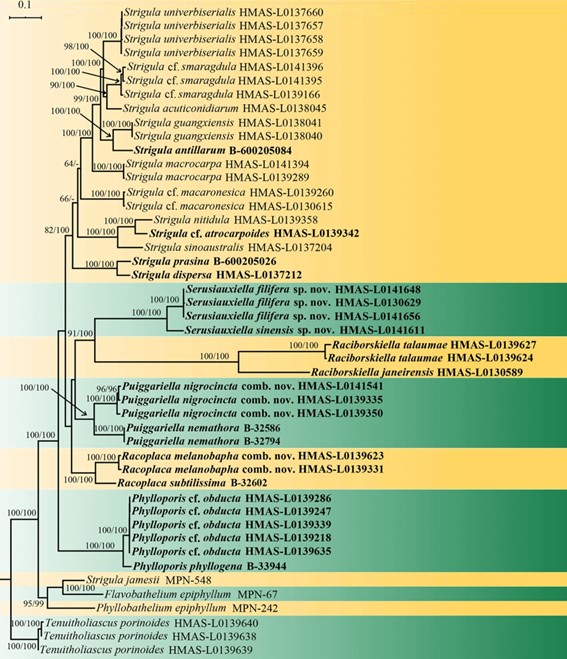Strigulaceae Zahlbr. in Engler, Syllabus, Edn 2 (Berlin): 46 (1898).
MycoBank number: MB 81870; Index Fungorum number: IF 81870; Facesoffungi number: FoF 08853; approximately 80 species (Lücking et al. 2017).
= Phyllobatheliaceae Bitter & F. Schill., Hedwigia, Beibl. 67: 272 (1927).
Type: Phyllobathelium (Müll. Arg.) Müll. Arg., Flora, Regensburg 73: 195 (1890).
Lichenized on leaves, bark or rocks in terrestrial, chiefly lowland to montane tropical to subtropical habitats, with few species extending into temperate regions. Thallus reduced and ecorticate, often white, to (pseudo-)corticate, grey-green to bright green, sometimes with metallic appearance. Photobiont Trentepohlia sensu lato (including Cephaleuros and Phycopeltis). Sexual morph: Ascomata perithecia, scattered, clustered, or aggregated in pseudostromata, immersed to prominent (to rarely sessile), mostly brown or black, rarely pale, often at least partly covered by thallus, globose to pear-shaped or conical, coriaceous to carbonaceous, ostiolate, ostiole round. Involucrellum present in some genera, usually carbonized. Excipulum dense, consisting of compressed hyphae, appearing prosoplectenchymatous in thin sections, but structure may be difficult to observe due to carbonization, hyaline to brown or brown-black. Hamathecium comprising 0.5–0.7(–1.5) µm wide paraphyses, hyaline, flexuous, unbranched or branched to sparsely anastomosing. Asci (1–)8-spored, bitunicate, fissitunicate, obclavate to mostly cylindrical, shortly pedicellate, with narrow to somewhat broader, ocular chamber, non-amyloid. Ascospores irregularly arranged to uni- or biseriate, fusiform to ellipsoid, hyaline, septate to muriform, with eusepta and rectangular lumina, smooth-walled, often constricted at the septa. Asexual morph: Pycnidia common, immersed to erumpent, often visible as black dots, rarely pale and inconspicuous, sometimes in specific, pseudostromatic areas, or whole thalli only producing pycnidia. Conidia acrogenous, either macro- or microconidia; macroconidia 1-septate to rarely muriform, ellipsoid to bacillar, sometimes becoming rather large, with variously shaped gelatinous appendages, hyaline; microconidia usually aseptate, fusiform-ellipsoid to bacillar, small, hyaline.
Chemistry: Most species do not contain secondary substances. Crystalline anthraquinone pigments are found in Flavobathelium.
Type: Strigula Fr., Syst. Mycol. 2(2): 535 (1823).
Notes: For a general discussion of the family see Lücking & Nelsen in Hyde et al. (2013; Strigulaceae). Recently, a new family, Tenuitholiascaceae, with the single genus, Tenuitholiascus, was established to accomodate a novel lineage sister to Strigulaceae, but with a different ascus type (Jiang et al. 2020a). Simultaneously, molecular phylogenetic analysis focusing on a broad set of foliicolous species hitherto assigned to the genus Strigula demonstrated that the latter is heterogeneous and can be divided into six genera, all characterized by a combination of morphological and anatomical features (Jiang et al. 2020b). Given that S. jamesii, the only non-foliicolous representative of Strigula sensu lato sequenced so far, is unrelated to the six foliicolous clades and positioned far from Strigula sensu stricto (Fig. 70), here we consequently also reassess the generic classification of non-foliicolous representatives so far placed in this genus. Based on characters of the ascospores and macro- and microconidia, three further genera are recognized: Phyllocharis Fée, for the anatomically unique foliicolous taxon, Strigula orbicularis Fr.; Dichoporis Clem., for non- foliicolous species with 1-septate ascospores, 1-septate macroconidia and chiefly fusiform microconidia; and the newly established genus Swinscowia S.H. Jiang, Lücking & Sérus., for non-foliicolous species with multi-septate to muriform ascospores, multi-septate to muriform macroconidia and chiefly bacillar microconidia. Dichoporis is closely related to Phylloporis Clem., but we keep the two groups separate largely based on the different substrate and photobiont, as molecular data for foliicolous lineages indicate photobiont preference, to be interpreted as a mycological character of mycobiont-photobiont compatibility, be consistent within a lineage. The same applies to Swinscowia in relation to the foliicolous genus Phyllocratera Sérus. & Aptroot.
Both Index Fungorum and MycoBank list Strigulaceae A.B. Frank (Frank in Leunis 1877) as valid name for the family, antedating Strigulaceae Zahlbr. However, this is not correct. Frank did not publish a new name but cited Strigulini Fr., which was originally established as the name of a suborder (Fries 1825). Names cannot be used unchanged at different ranks unless they are descriptive and not automatically typified (ICN Art. 6, Note 3, and Art. 16.1), and the name Strigulini is derived from the genus name Strigula and hence automatically typified. Also, the use of names at different ranks, yet unchanged, does not apply to the level of family. Therefore, Frank’s use of the name Strigulini Fr. as “Familie” (Frank in Leunis 1877: 1699) does not constitute valid publication of a name at family level that is to be corrected with unchanged authorship (ICN 18.4); instead it is to be considered a misapplication of an existing name at a different rank.

Fig. 70 Best scoring maximum-likelihood tree (also including Bayesian posterior probabilities) of Strigulaceae showing the currently recog- nized and sequenced genera (adapted from Jiang et al. 2020b; see that reference for further details)
Genera
